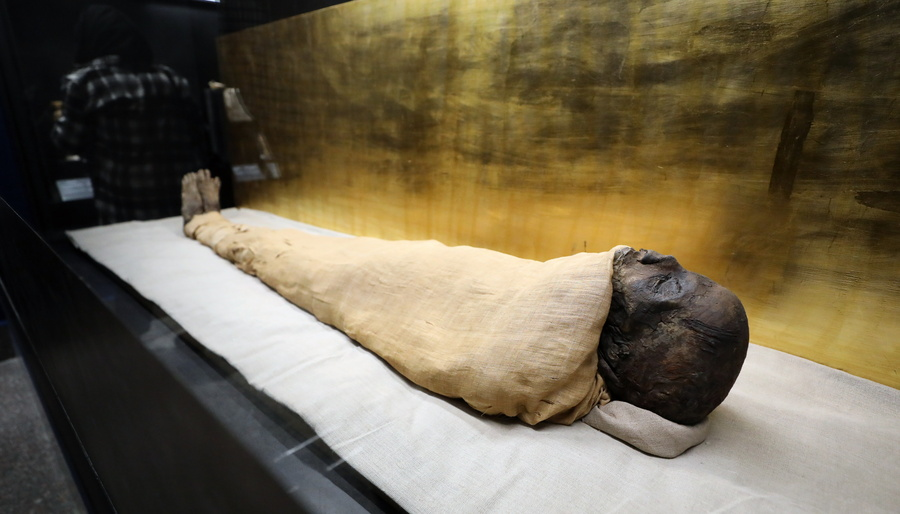An analysis of the dental plaque sheds light on the forgotten history of the female monastic copyists of the era.
What Anita Radini noticed under the microscope was blue – a brilliant blue that looked so unnatural, so out of place in the 1,000-year-old dental calculus she was gently dissolving in mild acid.
It was hypermarine, she would later learn, a pigment that a millennium ago could only have come from lapis lazuli sourced from a single region of Afghanistan. This blue was once worth its weight in gold. It was mainly used to give the striking color to the garments of the Virgin Mary in works of art for centuries. And the teeth embedded in that blue probably belonged to a scribe or painter of medieval manuscripts.
The Mystery
Who was this person? A woman, first of all. According to radio dating, she lived from about 997 to 1162 and was buried in a nunnery in Dalheim, Germany. And so those embedded blue particles in her teeth illuminate a forgotten story of medieval manuscripts: They weren't just made by monks. In the medieval centuries, nuns also produced the famously laborious and beautiful books. And some of these women must have been very good, if they used a pigment as precious and rare as hypermarine.
If pigments can be preserved in calculus—the yellow substance on teeth that hardens plaque—that means fibers, minerals, and other pigments could be preserved, too. "This is a really big deal," says Mark Clark, an art historian at Nova University in Lisbon, who was not involved in the new study. You could imagine identifying metalworkers, carpenters and other craftsmen by the particles embedded in the calculus, Clark says. "This opens up a new avenue in archaeology."
The impressive blues
Radini and her co-author, Christina Warriner, did not set out to study the production of illustrated manuscripts. Radini, now at York University, was initially interested in the starch grains in stone as a food substitute, and Warriner, a microbiome researcher at the Max Planck Institute, wanted to study the DNA of ancient oral bacteria. But the blue particles were too impressive to ignore.
"Can you imagine the kind of frantic phone calls we had to make at first?" says Warriner. “Hey, I'm working with this tooth thing, and it's about 1,000 years old, and it has blue stuff in it. Can you help me;". People thought we were crazy. We tried to reach out to physicists and they said, "I don't know what you're talking about." We tried to reach out to people who are involved in art restoration and they were saying, 'Why are you working with tooth plates?'" It eventually reached physicists at the University of York, who helped confirm that the blue did indeed come from the mineral lapis lazuli, derived from lapis lazuli.
A woman painter?
But art experts were still wary. Some rejected the idea that a woman could be a painter skilled enough to work with supermarine. Someone told Warriner that this woman came into contact with the hypermarine because she was just the cleaner.
Warriner eventually turned to Allison Beach, an Ohio State University historian who studies women scribes in 12th-century Germany. Over the past two decades, Beach and other scholars have documented the overlooked contribution of women to medieval book production. The challenge, Beach says, is that while most signed manuscripts are by men, the vast majority of manuscripts are unsigned. But a small number of surviving manuscripts are signed by women, and scholars have found correspondence between monks about book production.
Beach even found a letter dated to the year 1168 in which an accountant of a men's monastery commissions Sister "N" to create a luxurious manuscript using precious materials such as parchment, leather and silk. The convent where Sister "N" lived is only 40 miles from Dalheim, where the lapis lazuli teeth were found. Beach also identified a lapis lazuli book written by a female scribe in Germany around 1200 AD. The dye had traveled nearly 4,000 miles from Afghanistan to Europe via the Silk Road. All evidence indicates that female scribes were indeed making books using lapis lazuli pigment in the same region and around the same time as this woman lived.
But how did it get there?
The team considered a number of alternative ways in which the lapis lazuli could have ended up in the woman's dental plaque. Could it be derived from lapis ingested as a medicine, as suggested in Greek and Islamic medical texts? The lapis lazuli particles were also extremely fine, requiring a painstaking grinding process. This detail in particular suggests that the stones were deliberately made in pigment.
The team concluded that two scenarios are most likely: either she inhaled the dust while preparing the dye for herself or for someone else. You can almost begin to imagine her, Beach says, sitting alone and toiling away at a manuscript day after day. "For a medieval historian this kind of clear material evidence of something from a single person's life is so extraordinary."
Cynthia Cyrus, a professor at Vanderbilt who has also studied medieval scribes said reading the document was "the highlight of her day." Like many monasteries, he noted, the one where this woman was buried was eventually destroyed in a medieval fire. There is little evidence of what life was like there. But the woman's teeth suggest it could have been a highly specialized book production site.
Warriner continues to study the particles embedded in old dental plague. She and others have found everything from insect parts and exotic flower pollen to opium, bits of wool and milk proteins – all of which tell stories about what people ate and how they lived. The detritus of everyday life accumulates in the dental cavities that modern dentists are so careful to disinfect. "They don't think about future archaeologists," Warriner jokes.








